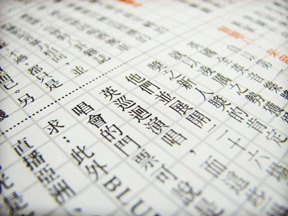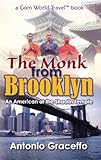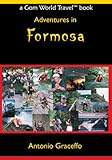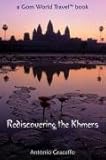How Many Words is Fluent?
Guest post by Antonio Graceffo
Antonio Graceffo is an applied linguist, and martial arts and adventure author living in Asia (check out our interview with him here). His books, including ”The Monk from Brooklyn”, are available at Amazon.com .
.
 Googling around the internet I found a lot of sites where people had written in saying, “I am studying language XYZ, and I want to know how many words I have to know to be able to read a newspaper.”
Googling around the internet I found a lot of sites where people had written in saying, “I am studying language XYZ, and I want to know how many words I have to know to be able to read a newspaper.”
This question is particularly relevant for people who are studying Chinese, where each word is a character, and most students know the exact number of characters that they can read. Whereas students who have been studying Spanish, German, or Vietnamese for a period of years, wouldn’t generally know the exact number, or may not even know an approximate number of words that they understand.
This information is relevant for anyone studying a foreign language, including English, particularly if your goal is to study at a university overseas or to work in a professional job in the foreign language environment.
Checking a number of websites, the answers varied substantially.
On aksville.com, someone took the time to write a long reply, explaining that major newspapers, such as USA Today, are written at a 6th to 8th grade level and require approximately 3,000 words to read.
Another site, called blogonebytes.com: “I read somewhere that to be able to carry on a good conversation in “Mandarin Chinese” one should know about 3,000 characters, and about 7,000 characters to read technical books.”
A follow up comment by a reader on the same site said, “You will need to know a minimum of 3000 characters to be proficient. You will need to be able to speak and understand in the range of 5000-7000 characters.”
According to Omniglot, a site which I tend to have a lot of respect for, “The largest Chinese dictionaries include about 56,000 characters, but most of them are archaic, obscure or rare variant forms. Knowledge of about 3,000 characters enables you to read about 99% of the characters used in Chinese newspapers and magazines. To read Chinese literature, technical writings or Classical Chinese though, you need to be familiar with at least 6,000 characters.”
I had always heard that the range was somewhere between 1,500 and 3,000 words to read a newspaper. In the case of Chinese, I know that I can read right about 3,000 characters, and yet, I absolutely cannot read a newspaper. If you hand me a newspaper, I can pick out words that I know, but I can’t actually read and understand the stories.
In Bangkok, I have several friends who are extremely conversant in Thai, and they can read a menu. But they would need an entire day and a dictionary to read a single newspaper story. And even then, they wouldn’t understand everything.
With German, after four years of studying and working as a translator and researcher in the country, I can obviously read anything. But, I have no idea how many words I know. Now that I am embarking on my study of Bahasa Malay, and also making plans to go back and finish learning Vietnamese, I am becoming very curious how long it will take to get my reading level anywhere close to what it is in English or Spanish. My own experience with Chinese made me question this 3,000 word figure. Also, as a person who earns most of his living from writing for magazines, newspapers, and books, I would hate to believe that I only write a 3,000 word vocabulary , and on a 6th to 8th grade level.
As many times as I attended 9th grade, you would think I would be writing at least at high school level.
The two facts that I wanted to verify were, the average reading level of The New York Times, my hometown paper, and the average number of words per edition.
The first question was easy to answer.
The May 2, 2005 edition of “Plain Language At Work Newsletter”, Published by Impact Information Plain-Language Services, explained that there are two generally accepted scales for determining the reading level of various publications. They are the Rudolph Flesch Magazine Chart (1949) and the Robert Gunning Magazine Chart (1952). Both charts analyzed such aspects of a magazine or newspaper such as, average sentence length in words and number of syllables per 100 words. Based on this information, they assigned a school grade reading-level to the publication. According to this rating system, The Times of India was considered the most difficult newspaper in the world, with a reading level of 15th grade. The London Times scored a 12th grade reading level, as did the LA Times and the Boston Globe. The survey must have been flawed, however, because they assigned The New York Times a reading level of 10th grade, which is lower than the LA Times, when everyone knows quite well that New York is better than California or any other place which is not New York.
If you get most of your news from Time Magazine, you might be pleased to know that Time and TV Guide both scored a 9th grade reading level.
The survey didn’t cover newspapers written in languages other than English, but if we assume that we are shooting for an average 10th grade level, this will probably be close to what you need to read a newspaper in any language.
The next question was much harder to answer. How many words do I need to read the New York Times? I have never believed the low estimates of 3,000 or less, simply because every event that happens anywhere in the world, any human situation can appear in the Times as a news story and could of course, require the appropriate vocabulary.
To answer the question, I went to the June 4, 2010 New York Times online and I chose 8 articles, taken from several different sections, because I assumed they would all require different vocabulary. The stories were: “Pelicans, Back From Brink of Extinction, Face Oil Threat”, “BP Funneling Some of Leak to the Surface”, “John Wooden, Who Built Incomparable Dynasty at U.C.L.A., Dies at 99”, “An Appraisal : Wooden as a Teacher: The First Lesson Was Shoelaces”, “Should you be able to discharge student loans into bankruptcy?”, “On the Road to Rock, Fueled by Excess” as well as other tidbits, announcements and follow up articles.
In some cases, if the articles were very long, I didn’t take them in their entirety, assuming there would be much repetition of words.
In all, I took parts of about 8 stories, comprising 51 pages of text. The stories I took didn’t even represent 10% of the total content of this particular edition of The New York Time, June 4, 2010 online edition.
I pasted the words into a word document, converted them to a single column table, which ran over 450 pages long. Then I sorted the table alphabetically. Up to this point, it was easy, just pressing buttons. Next, I had to go through all 450 pages, all 10s of thousands of words, removing duplicates. It was one of the most tedious exercises I have ever conducted in my life. It was exactly the type of obsessive compulsive behavior that gets people locked up in mental institutions. It took 16 hours. By the 10th hour, I began hallucinating. Nearing the 12th hour, I believed I was a hummingbird of some kind.
I allowed plural forms of nouns, so I counted “car” once and “cars” once. I also included all forms of a verb, so “walk” once, “walked” once, and “walking” once. I counted proper nouns, including place names, as the names of people and countries will come up in the news and you need to know them. Also, in foreign language, particularly Asian languages, the grammatical forms and proper names may not even be recognizable if you haven’t studied and learned them.
When I was finished, I found that the random sampling of stories I chose contained 4,139 unique words. This was much higher than the estimates I had read on some websites, but was well in line with what I suspected. If I had the energy to complete a similar analysis of the entire edition, I would have to believe the number would increase. And if we monitored the newspaper over a period of one month, analyzing the text every day, and comparing the vocabulary against an accumulated list, I would imagine that it would grow. Most likely the difference in vocabulary from day to day would be small, but still, the necessary vocabulary would increase.
Comparing the dialogues in my Chinese textbooks with the vocabulary that appeared in these New York Times articles, much of what I learned in school was useless. For example, all foreign language textbooks have chapters devoted to shopping at the market, where you have to memorize tedious lists of Fruits and vegetables. In these Times articles, not a single fruit name was mentioned. Neither my Vietnamese, Chinese, or Bahasa textbooks include the names of heads of state of various countries. But obviously, these names came up in world news stories.
Below is a small sampling of words that I found in the news story which, I don’t know how to say in Chinese. Some of these words, I question, however, if the average 9th grader would know them. Do 9th graders know: abetted, absinthe, archeo-feminist, or bearish?
abetted albeit assesses bankruptcy biofuels able-bodied. Amandine assessment batch biography abortions ambivalent assets bawdy-sweet black-clad absinthe anachronistic asthmatic bearish bleak absurd. anarchic audience-pleasing Bedford blemish accord Appended aura befriended blockade across-the-board Archbishop autobiography behind-the-back blowout activists archeo-feminist autograph-seekers benefits bond Advocates articulate awfully best-selling booster aerodynamic assertion babbles bioenergy breakthrough
Names and proper nouns are important for understanding news stories. In language textbooks you may learn the names of major countries and the capital cities, but news happens in small cities and even villages as well. To read the news you need to know the names of political parties, famous people, economic theories, financial indices, global corporations, educational institutions, associations, and international organizations such as the UN.
All of these names were taken from the same collection of stories. Do you know how to say these in Vietnamese or write them in Thai?
Cypriot Delta Geneva Mediterranean Bihar Baltic Democrat Greece Nehru Turkish-controlled Brooklyn Denmark Uttar Metropolitan Nasdaq Iranian Dow Midwesterner Mayor Polytechnique Louisiana Durbin Scotch Reich Iskenderun. pro-Greek Dutch-Irish Rev. Latino Kentucky. California Baptist BENJAMIN Bonaventure/Agence Burke/Associated Cambridge Chicago-based Berkeley Pennsylvania. Bush Cyprus Barataria-Terrebonne Navy BP Dallas-Fort Audubon Gandhi. Bess Dalit Arce
How many of the above terms were you able to translate or transliterate into the language that you study? This is the level of reading that an adult native-speaker can do, and this should be your goal. If the task doesn’t seem daunting enough, remember, in this article, we were only concerned with vocabulary. But you could have a vocabulary of a million words not be able to understand a newspaper or a book. For real communication, you need a comprehensive approach to language, which includes culture, syntax, context, and grammar.
It’s a long stretch. I know. And it can seem impossible. But remember, every Sunday in New York City Catholic mass is said in 29 languages. For more than a century, large numbers of immigrants, my family included, have been coming to America and Canada in search of a better life. Most of them learned English with less than half of the education of the average person reading this article.
So, if your Grandma and Grandpa could learn a new language to a level of functionality, so can you.
Like Antonio’s writing?
Check out some of his fantastic books on travel, martial arts, language learning and endangered cultures.
Republishing This Article
Want to share this on your site or blog? You are welcome to republish any articles by John Fotheringham. For guest posts, you must seek permission from the post author. For John's articles, please include the following at the top and bottom of the article when reposting:
Copyright © 2010 by John Fotheringham. For more tips, tools, and tech for Mastering ANY Language, go to LanguageMastery.com




Oh, dear. Please make friends with a programmer or two. Reading your article it made me ill to think of anyone working so hard to organize a word list when the whole thing could have been automated in less than an hour! Egad!
(Yes, an automatic system may not be able to tell when two non-hyphenated words should still be considered a single entity, but how to handle that situation is debatable anyway.)
You should count only the root form of a word as a unique entry rather than record every verb conjugation and word plural as a separate entry. This is how printed dictionaries list word definitions.
'In Chinese each word is a character'
This is definitely not true. Each syllable is a character and most Chinese words consist of two (or more) characters.
Anyway. I think that for a native speaker of Chinese 3000 learned characters is enough to read the newspaper, because they can infer the meaning and pronunciation of unknown characters.
For us non-native speakers 3000 might not be enough, even though it is possible to guess the probable pronunciation after learning 3000 characters.
I agree that each character is a syllable. But there is not even one Chinese character which is not a word by itself. If there are any, they are the exception and not the rule. It is not strictly true that Chinese words are composed of more than character. what is true is that many Chinese words are compound words. so, they are composed of more than one word. for example, "police" and "man" can stand alone as words or be combined into a compound word.
Native speakers absolutely cannot infer the pronunciation of an unknown character. If they haven't specifically studied and learned that character before, even native speakers can not guess at the pronunciation, although they may be able to guess at meaning.
I know this is an old post but felt after reading I should comment. As Peter said in chinese a character is not a word most words are multi character and to understand a character i think you need to know several words that it is in to understand the nuances of it. Also in Chinese the language is very informal words change/break up and used in different ways to more formal languages like European languages. For my thought in Chinese you need to know about 6000-7000 words to be able to read newspaper, these words would contain about 2500 characters though maybe a few would be not understood exactly but you can understand the meaning from the context.
I agree with you that the number is closer to 6,000 or 7,000. You made an interesting point that, although we need 6,000 to 7,000 words, this may only represent 2,500 individual characters. That is a good point. perhaps that is where the lower end estimates came from when i encountered texts which claimed you only needed 1,500 or 2,500 characters to read a newspaper.
Isn't English one of the biggest languages, in terms of raw number of words, though? I would expect the NYT to contain more words than, say, a Japanese newspaper.
Also, while English is largely derived from Latin and Greek, many other languages are built from themselves. A giant German word is made up of 4 tiny German words. A giant Japanese word is made up of 4 joyo kanji.
I would expect, based on what little of these languages I know, for English to be at or near the difficulty limit. If you're learning anything else, it will probably be easier than these numbers indicate!
Martin, good point. english is about 65% German and 30% Latinate (through French). and the rest is mixed. Or, those were the old numbers, in the 1980s. Today, we would definitely need to separate American English from British English and look at words borrowed from Spanish and other immigrant languages in US. But you are absolutely correct, American English has the largest lexicon, the most words, of any language that has ever existed. It is estimated that English has over 1 million words, where Italian has 200 or 300,000 and Khmer has only tens of thousands. When you work in science, medicine and other fields which need very specific definitions, such as "The patient has a fever." As opposed to "elevated body temperature." English is one of the few languages that could express these nuances of meaning.
I'd love to get one of MR. Antonio books..here he wrote in such a 'cute' way!.Study foreign language (any language) always fascinating me while most of my high school buddies said it was such a boring!.English is hard to learned,bunch of tenses,grammar that make your head spinning..
Hidaya, thanks for making me smile. I agree, English can make your head hurt. Remember, I come from a home where we spoke Italian and Spanish. So, I understand how hard it is to learn English.
Hi Hidayah. I will pass on your kind words to Antonio; I am sure he will appreciate it. Incidentally, all of his books are available on Amazon. Just click one of the book cover images above.
With regard to learning English (or any language for that matter), the good news is that you don't need to spend very much time consciously studying vern tenses and grammar, and in fact, doing so is often the reason people can never learn a language well. They spend almost all their time learning information ABOUT the language (i.e. building their declarative memory) and not enough time actually listening to and speaking the language (i.e. building their procedural memory).